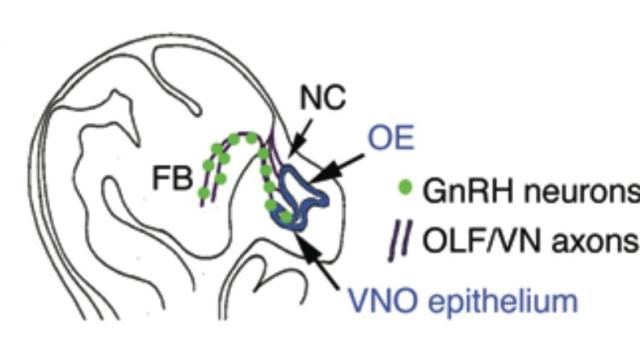Sometimes, bad luck leads to insights. A study published today in the Journal of Clinical Investigation has added a new twist to the way the system that controls puberty in mammals develops inside the brain, thanks to two brothers who both inherited a combination of genes for Kallmann syndrome.
Kallmann syndrome is a rare genetic disorder that prevents or delays puberty and is often paired with ansomia — an inability to smell. Both characteristics are caused by the loss of neurons that first arise inside the nose: missing olfactory neurons cause the lack of smell, and a loss of neurons that make gonadotropin-releasing hormone (GnRH) affect sexual development.
Normally, the neurons that will eventually secrete GnRH migrate through the brain until they reach their final position deep inside the hypothalamus. Once there, these brain cells serve as a sort of “master switch” for the reproductive system, triggering adult patterns of hormone secretion at puberty and controlling the activity of testes and ovaries throughout adulthood.
GnRH neurons are missing in people with Kallmann syndrome. It’s long been assumed that people affected by the syndrome have mutations that somehow keep GnRH neurons from finding their way to the hypothalamus. But research led by Anna Cariboni, now at the University of Milan, and Christiana Ruhrberg, at University College London’s Institute of Ophthalmology, shows that, at least for these two brothers, the problem is untimely death rather than misdirection. Their results were published today
By screening both brothers’ genes, the researchers identified a mutation in a protein called semaphorin 3E (SEMA3E). The name of the protein hints at what it does: it’s a signal molecule, a waving flag that acts as a guide inside the developing brain. It’s known to trigger blood vessel development and neuron migration, but the researcher’s experiments in tissue cultures and mice showed that it was doing something else entirely for GnRH neurons.
When Cariboni and Ruhrberg’s team studied mice that had been given the brothers’ mutant version of SEMA3E, they found that GnRH neurons didn’t get lost between the nose and the hypothalamus. They found their way to the correct brain region without a hitch. But once the neurons got there, they died. Nothing attacked them or killed them — for some reason, the cells simply self-destruct.
In normal mice, the researchers found, SEMA3E attaches to specific proteins on the GnRH neurons and prevents self-destruction. Cariboni says that they still don’t know which brain cells make SEMA3E in the hypothalamus, but they can see that GnRH neurons actively change their protein coats as they migrate to make themselves more visible to the signal. As they do so, the neurons essentially prevent their own early suicide as they move to the spot where they will manage sexual behaviour.
[Source: Cariboni et al. 2015]
Image: Cariboni et al. 2015.
